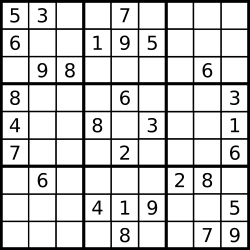36. 有效的数独
发布时间:2024年01月23日
请你判断一个?9 x 9?的数独是否有效。只需要?根据以下规则?,验证已经填入的数字是否有效即可。
- 数字?
1-9?在每一行只能出现一次。 - 数字?
1-9?在每一列只能出现一次。 - 数字?
1-9?在每一个以粗实线分隔的?3x3?宫内只能出现一次。(请参考示例图)
注意:
- 一个有效的数独(部分已被填充)不一定是可解的。
- 只需要根据以上规则,验证已经填入的数字是否有效即可。
- 空白格用?
'.'?表示。
示例 1:

输入:board = [["5","3",".",".","7",".",".",".","."] ,["6",".",".","1","9","5",".",".","."] ,[".","9","8",".",".",".",".","6","."] ,["8",".",".",".","6",".",".",".","3"] ,["4",".",".","8",".","3",".",".","1"] ,["7",".",".",".","2",".",".",".","6"] ,[".","6",".",".",".",".","2","8","."] ,[".",".",".","4","1","9",".",".","5"] ,[".",".",".",".","8",".",".","7","9"]] 输出:true
示例 2:
输入:board = [["8","3",".",".","7",".",".",".","."] ,["6",".",".","1","9","5",".",".","."] ,[".","9","8",".",".",".",".","6","."] ,["8",".",".",".","6",".",".",".","3"] ,["4",".",".","8",".","3",".",".","1"] ,["7",".",".",".","2",".",".",".","6"] ,[".","6",".",".",".",".","2","8","."] ,[".",".",".","4","1","9",".",".","5"] ,[".",".",".",".","8",".",".","7","9"]] 输出:false 解释:除了第一行的第一个数字从 5 改为 8 以外,空格内其他数字均与 示例1 相同。 但由于位于左上角的 3x3 宫内有两个 8 存在, 因此这个数独是无效的。
提示:
board.length == 9board[i].length == 9board[i][j]?是一位数字(1-9)或者?'.'
方法1:

public static boolean isValidSudoku(char[][] board) {
String[] rows = new String[9];
String[] columns = new String[9];
String[] areas = new String[9];
for (int i = 0; i < 9; i++) {
if (rows[i] == null){
rows[i] = "a";
}
for (int j = 0; j < 9; j++) {
if (columns[j] == null){
columns[j] = "a";
}
if (rows[i].contains(board[i][j] + "")){
return false;
}else if (board[i][j] != '.' && !rows[i].contains(board[i][j] + "")){
rows[i] += board[i][j];
}
if (columns[j].contains(board[i][j] + "")){
return false;
}else if (board[i][j] != '.' && !columns[j].contains(board[i][j] + "")){
columns[j] += board[i][j];
}
int row = i / 3; // 0 1 2
int column = j / 3; //0 1 2
int area = row * 3 + column;
if (areas[area] == null){
areas[area] = "a";
}
if (areas[area].contains(board[i][j] + "")){
return false;
}else if (board[i][j] != '.' && !areas[area].contains(board[i][j] + "")){
areas[area] += board[i][j];
}
}
}
return true;
}方法2:(0ms)
public boolean isValidSudoku(char[][] board) {
short[] rows = new short[9];
short[] cols = new short[9];
short[] squares = new short[9];
for (int i = 0; i < 9; i++) {
for (int j = 0; j < 9; j++) {
if (board[i][j] != '.') {
short value = (short)(1 << (board[i][j] - '0'));
int boxNum = i / 3 * 3 + j / 3;
if ((rows[i] & value) != 0 || (cols[j] & value) != 0 || (squares[boxNum] & value) != 0) {
return false;
}
rows[i] |= value;
cols[j] |= value;
squares[boxNum] |= value;
}
}
}
return true;
}方法3:(1ms)
public boolean isValidSudoku(char[][] board) {
int[] rows = new int[9];
int[] cols = new int[9];
int[] subboxes = new int[9];
for (int i = 0; i < 9; i++) {
for (int j = 0; j < 9; j++) {
char c = board[i][j];
if (c != '.') {
int x = (1 << (c - '1'));
if ((rows[i] & x) != 0) {
return false;
} else {
rows[i] |= x;
}
if ((cols[j] & x) != 0) {
return false;
} else {
cols[j] |= x;
}
if ((subboxes[i / 3 * 3 + j / 3] & x) != 0) {
return false;
} else {
subboxes[i / 3 * 3 + j / 3] |= x;
}
}
}
}
return true;
}方法4:(2ms)
public boolean isValidSudoku(char[][] board) {
int[][] row = new int[9][9]; // 行
int[][] columns = new int[9][9]; // 列
int[][][] a = new int[3][3][9];
for (int i = 0; i < 9; i++) {
Set<Character> set = new HashSet<>();
for (int j = 0; j < 9; j++) {
char c = board[i][j];
if (c != '.') {
row[i][c - 49]++;
columns[j][c - 49]++;
a[i / 3][j / 3][c - 49]++;
if (row[i][c - 49] > 1 || columns[j][c - 49] > 1 || a[i / 3][j / 3][c - 49] > 1) {
return false;
}
}
}
}
return true;
}
文章来源:https://blog.csdn.net/linping_wong/article/details/135760616
本文来自互联网用户投稿,该文观点仅代表作者本人,不代表本站立场。本站仅提供信息存储空间服务,不拥有所有权,不承担相关法律责任。 如若内容造成侵权/违法违规/事实不符,请联系我的编程经验分享网邮箱:chenni525@qq.com进行投诉反馈,一经查实,立即删除!
本文来自互联网用户投稿,该文观点仅代表作者本人,不代表本站立场。本站仅提供信息存储空间服务,不拥有所有权,不承担相关法律责任。 如若内容造成侵权/违法违规/事实不符,请联系我的编程经验分享网邮箱:chenni525@qq.com进行投诉反馈,一经查实,立即删除!
最新文章
- Python教程
- 深入理解 MySQL 中的 HAVING 关键字和聚合函数
- Qt之QChar编码(1)
- MyBatis入门基础篇
- 用Python脚本实现FFmpeg批量转换
- 钱数加s还是不加s?
- 【图像拼接/视频拼接】论文精读:Video Stitching for Linear Camera Arrays
- 【OAuth2】授权框架的四种授权方式详解
- 如何使用内网穿透工具实现Java远程连接本地Elasticsearch搜索分析引擎
- GO语言工具函数库--Lancet
- YOLOv8改进 更换旋转目标检测的主干网络LSKNet
- HTTP 500错误:服务器内部错误,原因及解决方案
- 基于Spark个性化图书推荐系统
- Hadoop开发环境搭建
- 数据结构:跳表的原理和运用